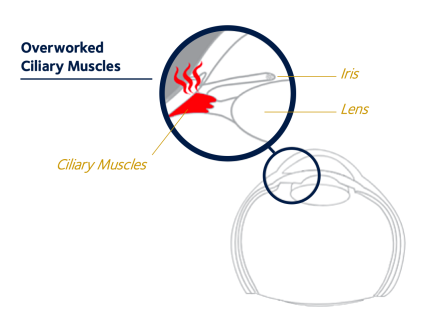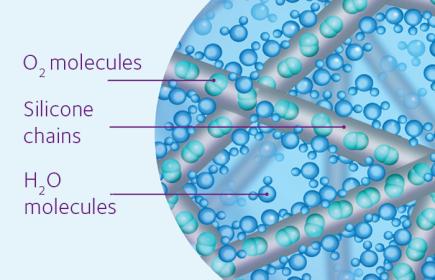
As Americans spend a significant portion of their days fixated on digital devices, they are frequently experiencing digital eye strain.
Your patients of all ages rely on digital devices to stay connected, productive, educated, and entertained. More than 67% of adults report using two or more digital devices simultaneously1.
A New Look at Digital Eye Strain
Exclusive U.S. consumer research from CooperVision shows screen time is still rising, digital eye strain is prevalent, and opportunity abounds for eye care professionals to help.
Download Report
How Digital Devices Affect Vision
Using digital devices can reduce a person’s blink rate2, sometimes causing eye tiredness and dryness, common symptoms of digital eye strain, which is ocular discomfort felt after only two or more hours in front of a digital screen3.
Your Patients Want Solutions
Nearly 4 out of 5 contact lens wearers are interested in knowing more about reducing eye strain and tiredness associated with digital devices4.
The Winning Technologies Behind MyDay Energys® and Biofinity Energys®
The unique combination of DigitalBoost™ technology and Aquaform® Technology in MyDay Energys® and Biofinity Energys® lead to robust contact lenses designed to help with eye tiredness and dryness associated with digital device use.
DigitalBoost™ Technology
DigitalBoost™ technology is an innovative single vision aspheric lens design that delivers a +0.3D boost, to help eye tiredness associated with digital device use.

DigitalBoost™ technology may help ease ciliary muscle stress from overworked muscles during digital device use and may help ease accommodative burden. This aids sphere patients’ eyes to better adapt when shifting focus between digital devices and the real world.
DigitalBoost™ technology wearers were significantly more likely than sphere wearers to say6:
- Their eyes felt less tired during or after working with a computer*.
- They didn’t have to strain to see well after some time working with a computer**.
- Their eyes hurt less when working with a computer.
- They didn’t have to blink a lot while using the computer at work†.
- They didn’t have heavy eyes at the end of a work day‡.
Aquaform® Technology
Aquaform® Technology is an advanced material technology that hydrates contact lenses to twice their weight in water7 for natural wettability and incredible comfort all day, which can help eyes to feel less dry, even during times of reduced blinking.

The main challenge with any silicone hydrogel contact lens material is finding the right balance of moisture content, oxygen transmissibility and modulus. CooperVision overcame this challenge by pioneering Aquaform® Technology, with a unique set of structures that are integrated throughout the lens material. More than 24 million wearers experience the great vision and incredible comfort that their eyes deserve thanks to Aquaform® Technology8.
How Aquaform® Technology works:
- It starts with a proprietary network of long and short silicone chains, which are then purposefully interlinked to deliver the right balance of high oxygen transmission7 and optimal modulus.
- Powerful hydrophilic arms on the silicone chain network attract and anchor water molecules making it highly compatible with the polymers throughout the entire lens matrix7.
What This Means for Your Practice
With MyDay Energys® and Biofinity Energys®, you have the opportunity to prescribe a lens that can help your patients with eye tiredness and dryness associated with digital device use—exactly what they need and want right now. Giving your spherical contact lens wearers a better lens-wearing experience could lead to higher patient retention and loyalty.
MyDay Energys® Specifications:
Material | Stenfilcon A |
Water Content | 54% |
DK/T (AT -3.00D) | 100 |
Base Curve | 8.4 mm |
Diameter | 14.2 mm |
Sphere Power | +8.00D to -12.00D (0.50 D steps after +5.00D and -6.00D) No Plano |
Technology | DigitalBoost™ technology and Aquaform® Technology |
Center Thickness | 0.08 mm at -3.00D |
UV Blocker҂ | Yes |
Replacement Schedule | Daily disposable |
Biofinity Energys® Specifications:
Material | Comfilcon A |
Water Content | 48% |
DK/T (AT -3.00D) | 171 |
Base Curve | 8.6 mm |
Diameter | 14.0 mm |
Sphere Power | +8.00D to -12.00D (0.50 D steps after +/-6.00D) No Plano |
Technology | DigitalBoost™ technology and Aquaform® Technology |
Center Thickness | 0.08 mm at -3.00D |
Wearing Schedule | Daily wear or up to 6 nights / 7 days extended wear |
Replacement Schedule | Monthly |
Provide correction for 99.9% of spherical prescriptions9,10.
§ Based on a statistically significant difference of the mean change in Accommodative Microfluctuations and when compared to a lens without DigitalBoost™/Digital Zone Optics® after reading on an iPhone 5 for 20 minutes held at a distance of 25 cm. Study conducted with Biofinity Energys and sphere.
*After 2 weeks of daily wear Biofinity 4,5 ± 1,4 and Biofinity Energys® 3,1 ± 1,5; p<0.05.
**After 2 weeks of daily wear Biofinity 2,8 ± 0,8 and Biofinity Energys® 1,9 ± 1,0; p<0.05.
†After 2 weeks Biofinity 2,9 ± 0,6 and Biofinity Energys® 2,2 ± 0,6; p<0.05.
‡After 2 weeks of daily wear Biofinity 3,0 ± 0,5 and Biofinity Energys® 2,0 ± 0,8; p<0.05.
҂Warning: UV-absorbing contact lenses are not substitutes for protective UV-absorbing eyewear, such as UV-absorbing goggles or sunglasses, because they do not completely cover the eye and surrounding area. Patients should continue to use UV-absorbing eyewear as directed.
1. Vision Council 2019. The Vision Council shines light on protecting sight and health in a multiscreen era. The Vision Council Shines Light on Protecting Sight – and Health – in a Multi-screen Era | The Vision Council. Accessed 2023.
2. Hall L, Coles-Brennan C. Digital eye strain: more screen time = more digital eye strain. Contact Lens Spectrum. 2015;30:38-40, 55.
3. Coles-Brennan C, Sulley A, Young G. Management of digital eye strain. Clinical and Experimental Optometry. 2019;102(1):18-29.
4. CVI data on file 2019. Online YouGov Plc survey (conducted 2017). n=9343 adults in Australia, France, US, Germany, UK, Japan and Spain. Data weighted representative of countries.
5. Kajita M et al. Changes in accommodative micro-fluctuations after wearing contact lenses of different optical designs. Cont Lens Ant Eye (2020) In Press https://doi.org/10.1016/j.clae.2020.03.003
6. Montani G, Treso F, Martena M. et al. Effects of different contact lens design on accommodative function and eyestrain symptoms of young adult subjects after VDT use. Presented at: 2021 BCLA Virtual Clinical Conference and Exhibition; June 13-14, 2021
7. CVI data on file 2022.
8. CVI data on file 2022. Based on global product sales and internal estimates of products using Aquaform® Technology over 12 months in 2022.
9. CVI data on file 2020. Rx coverage database n=120,406 eyes for Rx with <0.75DC; 14 to 70 years.
10. CVI data on file, 2020. Rx coverage database; 14 to 70 years; Rx with <0.75DC.





